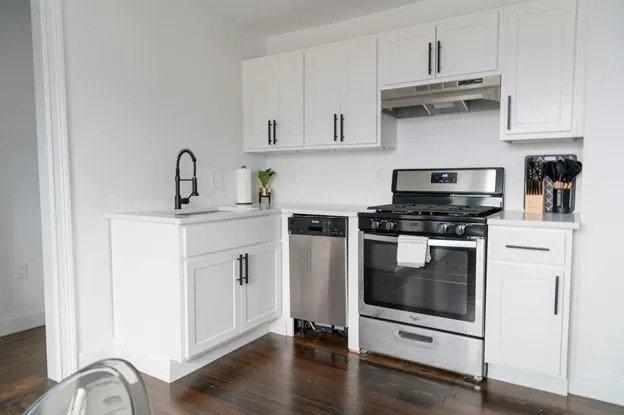
Transform Your Kitchen Cabinets Without Replacing Them: A Guide
Upgrading your kitchen doesn't always require a complete overhaul. For homeowners seeking a fresh look without the mess and expense of full cabinet replacement, cabinet refacing offers an efficient solution. Refacing revitalizes your kitchen's appearance by updating exterior surfaces while preserving the cabinet framework. A practical approach delivers significant aesthetic improvements with minimal disruption.
Cabinet refacing involves replacing cabinet doors, drawer fronts, and hardware, and applying new veneers or laminates to visible surfaces. The method saves time and money while reducing waste, making it an eco-friendly choice. With many material and style options, you can customize your kitchen to match your personal taste. Let’s explore the step-by-step process to achieve a transformed kitchen through cabinet refacing.
Step 1: Evaluate Your Existing Cabinets
Start by assessing the condition of your cabinets to ensure the boxes are structurally sound. Cabinet boxes should show no signs of warping, damage, or major deterioration. Solid frames provide the foundation needed for a successful and durable refacing job. If the structure seems compromised, a professional consultation will determine the right solution.
Next, evaluate the kitchen layout and ensure it meets your needs. If the configuration and storage capacity work well, refacing is likely the right solution. Homeowners interested in layout changes or increased storage might need additional upgrades. Clarifying goals at this stage leads to better planning and results.
Define the style and design elements you want to incorporate into your space. Cabinet refacing offers a wide selection of door styles, finishes, and hardware options to help reflect your vision. Choosing the right combination of elements ensures your kitchen blends beauty and function. Reviewing design inspirations can help you make confident selections.
Establish a realistic budget based on materials and scope of customization. Refacing usually costs less than full replacement, but prices vary with chosen finishes and hardware. An accurate estimate from a professional keeps the project on track financially. Clear budget planning avoids surprises during the process.
Step 2: Choose Your Materials and Style
Choosing durable materials ensures your refaced cabinets will last and maintain their appearance over time. Common options include wood veneers, laminates, and thermofoil, each offering unique benefits. Wood veneers deliver a natural feel, while laminates and thermofoil provide color variety and easy cleaning. Material selection should match your lifestyle and maintenance preferences.
Explore cabinet door and drawer front styles that suit your home's overall design. Shaker, raised panel, and flat panel designs each provide distinctive aesthetics. The style should align with your home's architecture and your personal taste. Reviewing samples in your kitchen environment aids final decisions.
Select hardware that enhances the cabinet style and finish. Knobs, pulls, and hinges in materials like brass, stainless steel, or matte black help define the overall look. Hardware must also be ergonomic and durable for everyday use. Pairing function with design results in a better long-term experience.
Color coordination brings visual harmony to your kitchen. Choose tones that complement existing elements like quartz countertops, flooring, and appliances. Neutral shades create timeless appeal, while bold colors make impactful statements. Testing samples under kitchen lighting ensures accurate color representation throughout the day.
Step 3: Prepare the Workspace
Preparation is key to achieving a smooth cabinet refacing experience. Clear kitchen countertops and empty the cabinets before work begins. Protective coverings help shield floors and nearby surfaces from dust or damage. Good lighting and ventilation ensure a safe and comfortable workspace.
Carefully remove cabinet doors, drawer fronts, and all existing hardware. Label and organize each piece to make reinstallation faster and easier. Inspect the cabinet boxes for small repairs before installing new surfaces. Taking time for minor fixes leads to a better finished product.
Thorough cleaning is essential to support strong adhesion for veneers and laminates. Use gentle, grease-cutting cleaners to eliminate built-up residue. Light sanding improves the bonding surface without damaging the cabinet structure. Wipe away all dust and debris with a clean, damp cloth.
Gather your tools and materials before starting the project. Common tools include measuring tape, adhesive applicators, cutting instruments, and screwdrivers. A checklist can prevent delays caused by missing equipment. Review any product-specific requirements from the manufacturer to stay prepared.
Step 4: Apply New Veneers and Install Components
Begin refacing by cutting and applying veneer or laminate to the visible cabinet box surfaces. Accurate measurements help avoid gaps, overlaps, or waste of materials. Apply adhesive evenly and press materials firmly to avoid bubbles or misalignment. Allow proper drying time as specified for each material type.
Install your new doors and drawer fronts once the box surfaces are complete. Align each piece carefully to ensure consistent spacing and balance. Attach hardware such as handles and hinges, checking for stability and proper positioning. Make hinge and drawer slide adjustments for smooth function.
Review your cabinets to ensure everything looks and operates correctly. Make fine-tune adjustments as needed to correct alignment or appearance issues. Clean surfaces with soft cloths and safe cleaning products to remove fingerprints and installation debris. A final inspection confirms readiness for use.
Organize your kitchen items and return them to the refaced cabinets. Consider storage solutions like shelf liners or pull-out trays for added convenience. Use this opportunity to declutter and improve storage efficiency. Enjoy the benefits of your refreshed and more functional kitchen space.
Step 5: Maintain and Enjoy Your Updated Kitchen
Establish a simple cleaning routine to protect your refaced cabinets over time. Use non-abrasive cleaners and avoid soaking surfaces with water. Quick cleanup of spills prevents moisture damage and discoloration. Regular dusting keeps cabinets looking polished.
Address minor damage promptly to prevent worsening over time. Many small chips or scratches can be repaired with touch-up kits. More serious issues may require expert help to maintain appearance and structural integrity. Timely maintenance protects your investment.
Add small updates as needed to refresh your kitchen’s style. New hardware or decorative touches offer seasonal updates without major changes. Staying current with trends keeps your space feeling new. Continuous improvements provide enjoyment long after the project ends.
Encourage friends and family to consider cabinet refacing for their own homes. Sharing your experience may help others explore practical remodeling options. Quality results speak volumes through word-of-mouth referrals. A beautifully refaced kitchen adds pride and lasting value.
Update Your Kitchen Cabinets Painlessly
Transforming your kitchen cabinets without replacement is an efficient way to refresh your space while maintaining functionality and structure. Refacing provides aesthetic upgrades with minimal disruption and long-term value. For expert cabinet refacing and full-service no-demolition remodeling, talk to us now. Our experienced team helps homeowners achieve stunning results with efficient, high-quality solutions.


